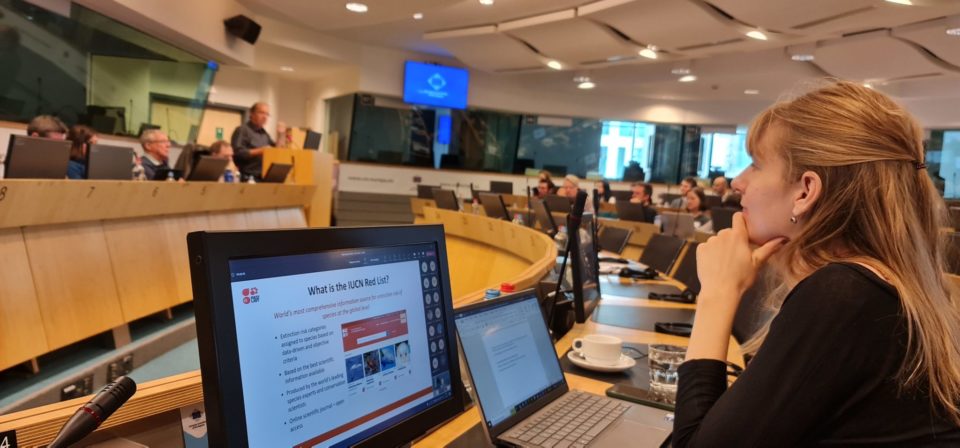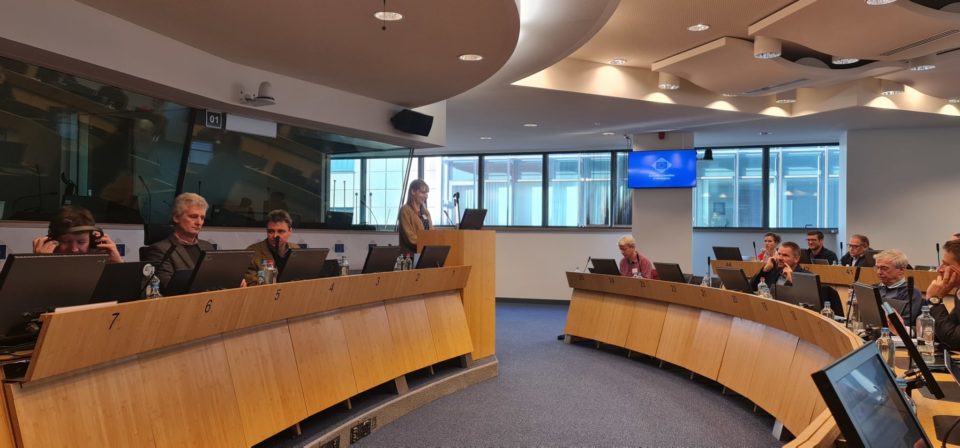
Policy makers, experts discuss role of EU biodiversity strategy in freshwater fish conservation
-
Biodiversity - Swimways
Policy makers from the European Commission, NGOs and researchers gathered together in late November to discuss the conservation of freshwater fishes in Europe in the context of the EU’s Biodiversity Strategy for 2030. The event, organised by the European Commission and the Living Rivers Europe coalition with the support of Wetlands International Europe, aimed to showcase the plight of freshwater fishes and share ideas for their conservation, policy and implementation measures.
Freshwater fishes are in unfavourable condition in Europe, facing numerous threats, including pollution, river barriers and invasive alien species. However, they remain neglected in biodiversity policy discussions. Therefore this event, which took place at the EU Committee of the Regions on 24-25 November 2022, presented an opportunity to discuss the current legislative framework and upcoming initiatives able to promote their conservation, including the proposed EU Nature Restoration Law (NRL).
Sibylle Schroer of the Leibniz Institute of Freshwater Ecology and Inland Fisheries, described the threats facing freshwater fishes. She outlined that various biodiversity hot spots are now being targeted for new dam projects, with long free-flowing rivers under particular threat. She emphasised the importance of education and connecting with civil society and the public when conducting conservation initiatives, for example, by bringing in local people to co-manage initiatives or sites. Initiatives such as the Leibniz Institute’s #FreshwaterFactCards aim to raise awareness about freshwater fishes and educate the general public about freshwater fish conservation.
Frank Vassen from the European Commission’s environment directorate-general (DG-ENV D3) provided an overview of the legal framework and the EU Biodiversity Strategy for 2030. The headline targets of the strategy are to establish a larger, coherent EU-wide network of protected areas (30% legal protection, 10% strict protection) and to develop an EU nature restoration plan. These are EU targets that then need to be translated into Member States’ own legislation at the national level. They are not legally binding and take the form of pledges to be submitted by the end of 2022.
The national pledges should list species and habitats in need of protection as well as a description of the measures to be taken (which kinds of measures, how many, when, and why they think that these are sufficient to achieve non-deterioration by 2030). An example given in the Flemish region of Belgium outlined the process for developing pledges through analysing Commission guidance, translating it into specific conditions and policies, developing draft scenarios, checking with stakeholders, and then making pledge decisions.

Jörg Freyhof from the IUCN Freshwater Fish Species Specialist Group pointed out that although freshwater fishes are the most threatened of Europe’s vertebrates, their conservation is often side-lined unless they have particular economic importance. Species richness is highest in southern Europe, especially Iberia, Croatia, Greece, the western Balkans, and the Black Sea. However, so far most conservation investment has been in northern Europe.
In 2023, the IUCN Red List will release updated data on freshwater fishes in Europe covering 695 species, 436 of which are endemic to the continent. The latest findings show that alien species are now the biggest threat to Europe’s freshwater fish diversity, soon to be replaced by climate change.
One of the major threats to freshwater species is barriers. When we think of river barriers, we often think of large dams, however 99.9% are small culverts, weirs, ramps or other smaller barriers. Carlos Garcia-De Leaniz, Swansea University, discussed the AMBER project, which has provided the first barrier atlas of Europe, documenting over 700,000 barriers.
While Europe’s rivers are the most fragmented in the world, they are also the most studied, providing opportunities for targeted conservation measures. Obsolete barriers, or unwanted fluvial objects (UFOs), present unprecedented opportunities for river restoration, and we now have the legal instruments at the EU level for removing them. While the EU Biodiversity Strategy and proposed Nature Restoration Law (NRL) encourage the reconnecting of 25,000km of river, it is important to target good habitat. It is vital that we understand where this is so as to achieve the largest impact.
The next part of the event shed a light on grayling conservation in several European countries, threatened in particular by cormorants. Invasive alien species were again named as a major threat. The Life Invasaqua programme in Spain and Portugal is focusing on this issue, seeking to raise awareness within the public and government, offering training, encouraging knowledge transference and synergies, as well as collaborating with national institutions.
A major take-away from the event was that the EU Biodiversity Strategy pledge process remains ongoing and that civil society organisations and conservationists should be communicating with officials in their national governments to participate. The pledge and review process is a huge opportunity for fish conservation but should not delay immediate actions.
Another major topic of discussion was the importance of connectivity for migratory fish species and ecosystem processes. The Danube Sturgeon Task Force was presented, showing the outcomes of the 2022 IUCN Red List assessment for sturgeons. This includes the regional extinction of the Ship sturgeon, the first time a species on a Habitats Directive annex has been declared extinct in the EU.
The Iron Gate dams are a major barrier in the section of the Danube river in Romania, so establishing a fish passage there would provide unhindered flow for very long stretches of river upstream. It was stated that the NRL in its current form would do little for long-distance migratory fish, treating river connectivity as an end in itself rather than a means to an end (providing passage for migration, including across jurisdictions, and ultimately improved biodiversity). Furthermore, research from the Leibniz Institute of Freshwater Ecology and Inland Fisheries has demonstrated the high mortality of fish when passing through hydropower turbines. A risk assessment of hydropower plants for fish, also by the Leibniz Institute, describes the parameters with the highest risks and how these can be overcome in the design of hydropower turbines.
Finally, although there are many challenges still to be overcome for effective fish migration, a theme of the event was hope. Freshwater fishes have very high resilience and have already survived numerous and largescale obstacles. Collectively, we are more aware of the threats they face, and events such as this one – as well as current and upcoming EU policies and laws – provide opportunities for new alliances and on-the-ground action.

The Trans-European Swimways Network, recently launched by Wetlands International Europe, aims to support the recovery of migratory freshwater fish in Europe by drawing attention to the plight of freshwater fishes, in particular river connectivity concerns, bringing stakeholders together and creating transboundary alliances.
